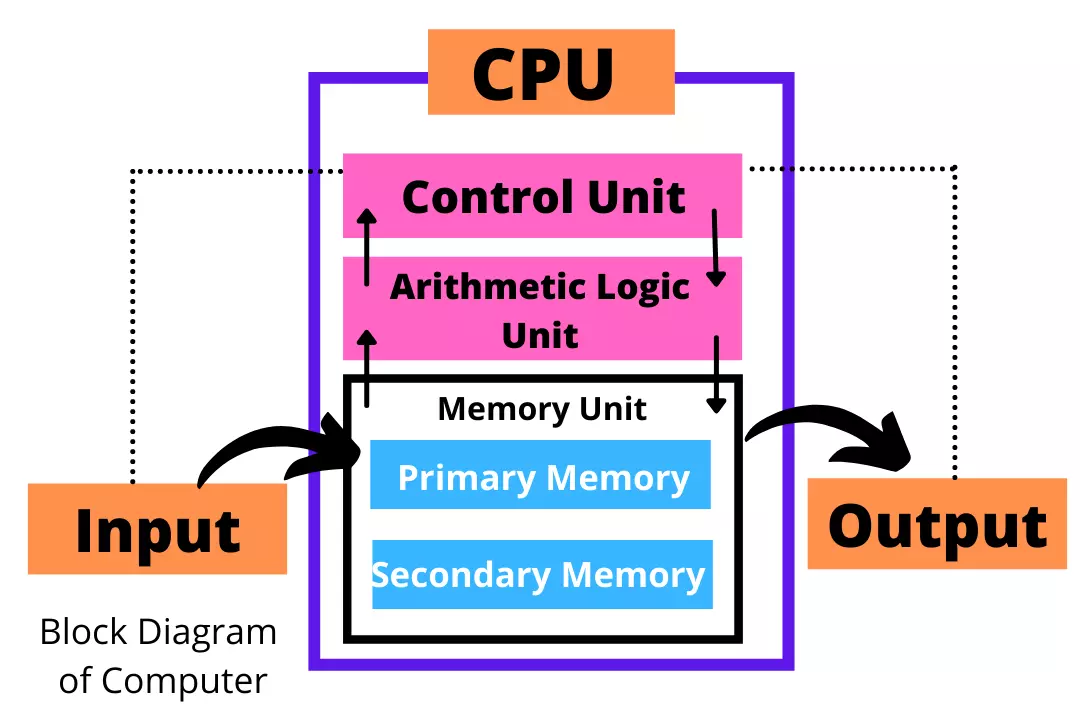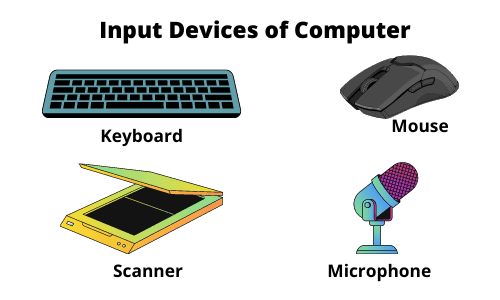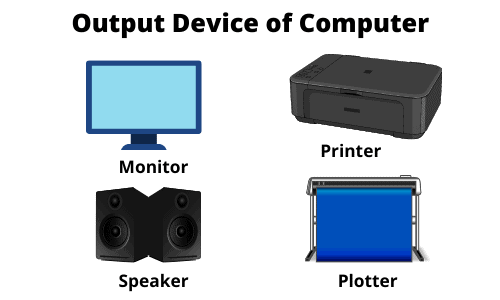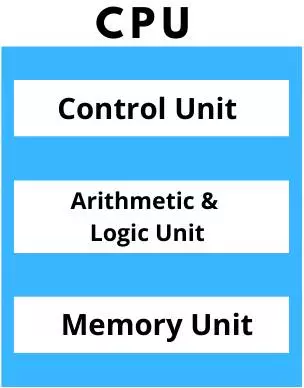Hello, Today we will know What is Block Diagram of computer system and its components are?
In this post, I will show you a block diagram of a computer with an explanation.
This Article is Best on the whole internet.
If you read this article carefully you will understand all about the block diagram of a digital computer. This topic is a part of the fundamentals of computers.
I Guaranteed you, after reading this article you will not need to read any other Articles. In fact, our reader’s satisfied with this blog post.
Note - The only purpose of this article is to tell you about computer block diagram in very simple language. This article has been written by an expert, if you think this article can be improved further, then you must give us feedback.
What is Block Diagram of Computer System?
Whatever instruction the computer receives from the user, then the computer completes that instruction block-wise.
The architecture of the computer is designed in such a way that to complete any instruction, the computer divides that instruction into its blocks so that that instruction is completed block-wise.
The method of making a computer block-wise is called a block diagram of a computer.
I explained the simple block diagram of computer picture in the given below.

I hope you understand this block diagram of the computer.
Components of Block Diagram of Computer
There are mainly three blocks in the computer, in these three blocks the computer divides any instruction, which is given below.
These all are the components of block diagram of digital computer.
Whatever instruction is given to the computer by the user, then the computer first sends that instruction to the input unit, after that the computer sends that instruction to the CPU, after that the computer sends the same instruction to the output unit.
Let us understand the computer block diagram in detail.
1. Input Unit
The instruction that the computer receives is the input unit.
Let us understand the input in detail.
A user gives any type of instruction to the computer by using the input unit to the computer.
Input unit means input device is used to input any kind of data into a user computer.
Because the computer does not understand the instruction of a user, so a user uses an input device to give instructions to the computer or to send raw data to the computer.
Because computers understand binary language, the input device sends the user's data in binary form to the computer.
There are many types of input devices such as keyboard, mouse, scanner and many more.
- Keyboard - We use the keyboard to input text data into the computer. Text data like - alphabet data - A, B, C, and numeric data - 1, 22, 985. There are different parts of keyboard.
- Mouse - With the mouse, we give instructions to open any application or file on the computer screen. There are many parts of mouse.
- Scanner - With the help of a scanner, we convert any hard copy data into soft copy data and enter that data into the computer. There are different parts of scanner.
- Input device is the medium of communication between the user and the computer.

Pictures of Input Devices of Computer
An important function of Input unit block
- Input device accepts and collects the data from the user.
- Input unit converts the user instruction to the Machine language, which the computer understands.
- After that, the input unit sends that instruction or data to the main memory of the computer for processing.
I hope you understand input unit block.
2. CPU - Central Processing Unit
CPU is the main part of the computer system. CPU is the brain and heart of the computer system.
All input and output devices are connected to the CPU itself.
All the instructions given to the computer by the user, all those instructions are executed by the CPU itself.
There are three main components in the CPU, with the help of which the CPU completes these instructions.
Those are the three main Components of CPU is - CU, ALU and MU.
The Important Function of CPU Unit
- Fetch the Data - Fetch means CPU reading the user instruction from the main memory.
- Decode - It means the CPU decodes the user instruction and understands the instruction of the user, what type of data is the user who has given the, what is the arithmetic data, is the logic data.
- Execute - It means the CPU executes the instruction given by the user and gives the user result.
CU - Control Unit
The Control Unit is the important component of the central processing unit which controls all activities of a computer system.
Controls unit the activity of all the input and output devices connected to the central processing.
For example, if a user has entered any data into the computer through the input unit, then the control unit itself controls the activity whether the data made by the user from the input unit is being stored in the memory or not.
After storing the data in the main memory of the computer, then whether the data is being fetched properly for data processing or not.
After data fetch, that data decode is happening properly or not.
Whether that data is being executed after decoded or not and whether it is giving the result to the user after being executed.
The control unit controls each and every instruction given by the user to the computer.
I hope you understand control unit.
ALU - Arithmetic Logic Unit
Arithmetic logic unit is the main components of CPU ( Central Processing Unit ).
When the user gives instruction to the computer through the input unit of any data, then that user's data from the input unit gets stored in the computer's main memory.
after that, ALU has to fetch that data and find what type of data the user inputted is logical data or arithmetic data.
Arithmetic Data - Arithmetic data means all mathematical calculation is called arithmetical data such as - addition, subtraction, multiplication, and division these all are arithmetic operations.
Logic Data - Logic data means perform logical operations like - AND, OR, NOT, NAND, NOR, XOR and XNOR these all are logical operation.
We understand logical data an easy way.
Whenever you open a file or folder on your computer screen, it is also a logical instruction or data.
Memory Unit
The memory unit is the main part of the computer system without which the computer is incomplete.
The other name of the memory unit is the storage unit of a computer system.
If your computer system has a memory unit, your computer will not even turn on or follow any instructions. The memory unit is present in every computer system.
There are two types of memory units. Primary Memory and Secondary Memory
1. Primary Memory
The primary memory also knows as the main memory of a computer.
Primary memory is a very fast memory. This memory reads and writes any data at a very high speed.
Primary memory is a very fast memory. This memory reads and writes any data at a very high speed.
This main memory is capable to received and send data for processing at high speed and this memory very closest to CU and ALU.
Main memory RAM does not have the capacity to store a large amount of data and the data stored in this memory is not permanent.
Main memory stores the input data made by the user. RAM and ROM are examples of primary memory.
There are two types of Primary Memory.
- RAM
- ROM
1. RAM Memory
RAM memory stands for Random Access Memory.
As the name of this memory suggests random access, random access means that this memory accesses anything immediately.
All the work currently happening in your computer is done in random access memory. This memory is also known as volatile memory.
This memory is faster than any other memory. Meaning that the processing power of this memory is very fast.
This memory stores your data for a short time and as soon as your computer system is shut down, this memory deletes all your data.
There are various functions of RAM Memory and there are many types of RAM Memory.
2. ROM Memory
ROM Memory stands for Read Only Memory.
As the name of this memory suggests, read-only memory, read-only means this memory can read any data directly. That is, this memory cannot change any data on your computer.
This memory is in every computer system, this memory is in the computer's motherboard. Read-only memory is also known as non-volatile memory.
This memory permanently stores your data so that you can use that data anytime.
You cannot delete or update ROM data. ROM memory in a computer has important functions. Well, there are many Types of ROM memory.
2. Secondary Memory
The secondary memory also knows as the Auxiliary memory of a computer.
This memory stored a large amount of data and its data is permanent data that can use in the future.
You can stored different types of data in this memory like - audio, video, image, text etc. Your computer hard disk is an example of secondary memory.
Secondary memory is not faster than primary memory. There are various types of Secondary memory, which are given below.
1. HDD
HDD stands for Hard Disk Drive. HDD is a storage device that is present in every computer. The function of a storage device is to store any digital data.
Digital data such as pictures, videos, audio, movies, word files, etc.
HDD is also known as a hard disk. These hard disks are cheap and today hard disks of all sizes are available in the market.
Like - 160 GB Hard Disk, 250 GB Hard Disk, 500 GB Hard Disk, 1 TB Hard Disk, 2 TB Hard Disk, which you can buy according to your work.
The hard disk spins at a speed of 7200 rpm. RPM stands for Revolution Per Minute.
The first computer hard disk was launched by the IBM company in 1956.
2. SSD
SSD stands for Solid State Drive.
It is also a type of storage device itself. You can also store any type of digital data in SSD. Digital data such as images, videos, audio, movies, word files, etc.
SSD is expensive as compared to a normal storage device because they are very powerful as compared to HDD.
SSD is not available on all computers. You have to install an SSD storage device separately. SSD is a non-volatile memory that works much faster than HDD.
3. Pen Drive
The pen drive is a types of secondary storage device. The Full name of pen drive is USB Pen Drive. USB stands for Universal Serial Bus.
A pen drive can store a minimum of 2 GB of data and is capable of storing data up to a maximum of 128 GB. People use pen drives to copy and paste data.
4. Optical Disk
An optical disc is an optical storage device found in every computer system. You can also store any type of digital data in an optical disc.
There are different types of Optical Disk, which are given below.
- CD ROM
- DVD
- Blu-Ray Disc
- RW Drives
3. Output Unit

Picture of Output Unit of Computer
Output unit also known as a output device of a computer system.
Output block is the main component of a computer because a user inputs any data, the computer processes that user's input data and gives the result as output and the output device is required to give output.
Output devices like - Monitor, Printer, Speaker, etc.
- Monitor - Whatever is visible on the monitor screen is output. For example - you gave the instruction to play the video and the video is played, the output is the video showing on your monitor screen.
- Printer - The printer is used to take out the soft copy that is on your computer into the hard copy. There are different parts of printer.
I hope you understand Output unit.
Conclusion
Through the summary, you understand the block diagram of the computer, how the computer completes an instruction block by block.
- Using input blocks, a user enters data into a computer.
- After that, whatever the user inputs, it gets temporarily stored in the primary memory of the data memory unit.
- After that, the input data is processed by the CPU.
- After processing, that data gets displayed on the resulting form of the output screen.
- After that, if you think that we will need this output in the future also, then you can save this output. This output is shifted from primary memory to secondary memory as soon as it is saved.
FAQ Related to Block Diagram of Computer
Q. How do you explain a block diagram?
You can easily explain the block diagram of the computer through the computer diagram itself step by step.
Q. How many blocks are there in computer?
Basically there are 3 three main blocks in the computer system.
Q. What are the basic blocks of a computer?
There are various blocks of a computer, which are given below.
- Input Unit
- Central Processing Unit
- Control Unit
- Arithmetic Logic Unit
- Memory Unit
- Output Unit
Q. How to Draw the Block Diagram of Computer System?
These questions are always asked questions in the exams of children. If you want to draw it on a hard copy then you will need a lot of practice.
So you can see our features image to practice and improve your practice.
If you want to make a Block Diagram of Computer in your computer system then you can make it very easily. You can take the help of many tools to make this diagram.
Or if you say, you can make it very easily by using these tools, the names of these tools are given below.
- MS Paint
- Canva
- EdrawMax
We hope that you have fully understood Block Diagram of Computer, if you still have not understood, then please comment on us.
If you liked this article, then you can share this post.
